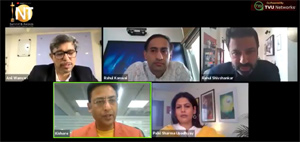KOLKATA: Major news channels in India have been criticised lately for turning primetime into a “farce”. The coverage of late actor Sushant Singh Rajput’s death has further tainted news media’s image, sparking the debate if they should relook at content. While some editors believe the industry needs to re-examine primetime, another section asserts they are doing it every day.
In a panel during NT Awards 2020 hosted by Indiantelevision.com and moderated by founder, CEO and editor-in-chief Anil Wanvari, renowned Indian journalists shared their views. Times Now editor in chief Rahul Shivshankar said that editors have always been singled out for the quality of news. But of late, a lot of control has been taken away from editors on what they can play. According to him, the industry is running on an unviable business model.
Shivshankar explained that news channels focus on TRP as it is intrinsically linked to advertising. He is of the view that if news business can be insulated from maniac TRP pressure and fluctuations, editors in the newsroom will be able to have control over the content. “The system for BARC to NBSA is very convoluted and needs to be brought down,” he added.
India Today and Aaj Tak news director Rahul Kanwal contradicted this view. He acknowledged that there is always pressure for ratings, business, advertising, but that is no reason to sell the soul. He emphasised that it is important to believe in the stories one is doing.

News channels have been roundly criticised for ignoring other important developing issues during the SSR incident, but Kanwal denied the charge. He said that it was not the only story covered by them and they gave equal importance to stories on the economy and the Covid2019 crisis. However, if something goes wrong, it is important to be open to fixing those mistakes, he added.
Wion executive editor Palki Sharma Upadhyay claimed that the TRP currency is flawed and the sample size is too small. Yet, some of the channels are dictated by the system. She also echoed Shivshankar’s view that the flaw of the system can’t be blamed entirely on editors. The blame is on viewers too because they watch those shows. But she also added that editors cannot deny the responsibility that comes with the position. She is of the view that there are various ways to bring revenue other than following the TRP model blindly.
Upadhyay also highlighted another issue that nowadays editors often follow social media agendas to decide primetime rather than applying their mind. Since the top editors themselves are influencers, they can prevent news content from turning into entertainment shows if they unite. Moreover, anchors need to stop being overdramatic as they are the face of news programmes, she added.
News18 India managing editor Kishore Ajwani agreed that primetime shows are identified with anchors. It is their opinion, and how they engage that leaves an impact. “I believe that all of us re-examine the prime time shows every day in all aspects – content, format, guests and others,” he said.
“At the end of the day, it’s a screen and you have got a remote. If you do not like a story, switch the screen. No one has put a gun to your head. We do what we believe should be done,” Ajwani declared.
Amid all the chaos, TRP and advertising have been blamed mostly for deterioration of news content. Times Now’s Shivshankar added that the channels should move to subscription led models gradually. He also noted that a huge chunk of Times Now’s revenue is coming from subscription.






